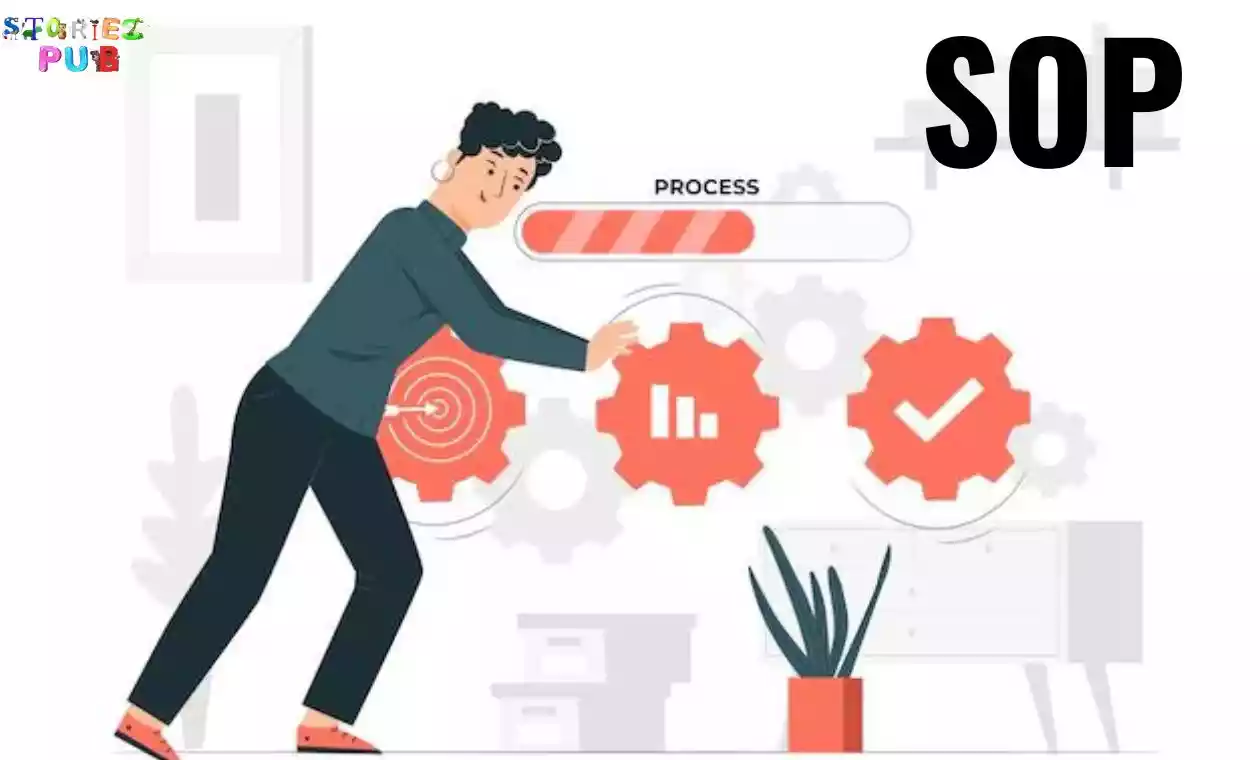SOP Full Form: What Does SOP Stand For and Its Brief History Explained

Standard Operating Procedures (SOPs) are securing documents that provide step-by-step guidance for various jobs and activities. SOPs promote uniformity, reduce risks, and boost efficiency. They are essential components of quality management systems and are utilized in a variety of settings, including healthcare, education, business, and government.
SOPs in healthcare ensure medical procedures are accurate and patients receive adequate care. SOPs in education ensure academic activities are carried out systematically and organized. SOPs in business guarantee that products and services meet quality standards and that staff adheres to specific norms. SOPs guarantee that regulations and policies are obeyed, and tasks are performed properly and effectively in government.
What Does SOP Stand For?
SOP stands for Standard Operating Procedure. It is a document that provides detailed instructions for carrying out a task or activity. SOPs are designed to ensure that tasks and activities are performed consistently and correctly every time. SOPs are commonly used in various fields, including healthcare, education, business, and government, to ensure quality, safety, and efficiency.
History of the term SOP
The term SOP has its origins in the military. In the 18th century, British soldiers referred to their rations as “SOP,” short for “standing operating procedure.” The term later evolved to describe a set of standard procedures or protocols for various military operations. The concept of SOPs was later adopted by businesses, healthcare organizations, and other industries as a means of standardizing procedures and ensuring consistency in operations.
Today, SOPs are an integral part of quality management systems and are used in various fields to ensure that tasks and activities are carried out correctly and efficiently. They provide a framework for operations and are critical to achieving quality, safety, and efficiency goals.
Examples of SOPs in Different Fields
Healthcare: In healthcare, SOPs are used to ensure that medical procedures and practices are performed safely and efficiently. Examples of SOPs in healthcare include hand hygiene protocols, medication administration procedures, patient care guidelines, and emergency response plans. SOPs are critical to ensuring that patients receive consistent, high-quality care and that healthcare providers follow established protocols.
Education: In education, SOPs are used to ensure that academic activities are conducted in a structured and organized manner. Examples of SOPs in education include attendance tracking procedures, grading policies, classroom management protocols, and lesson plan templates. SOPs ensure that educational activities are carried out consistently and efficiently, facilitating student learning and academic success.
Business: In business, SOPs are used to ensure that products and services meet quality standards, employees follow established protocols, and business processes are carried out consistently and efficiently. Examples of SOPs in business include customer service protocols, inventory management procedures, quality control processes, and marketing strategies. SOPs are critical to achieving business goals and improving productivity and efficiency.
Government: In government, SOPs are used to ensure that regulations and policies are followed, and activities are carried out efficiently and effectively. Examples of SOPs in government include emergency response plans, procurement policies, security protocols, and legal procedures. SOPs ensure that government activities are carried out in compliance with regulations and policies, promoting transparency, accountability, and efficiency.
Military: In the military, SOPs are used to standardize procedures for various military operations, ensuring that tasks are carried out consistently and safely. Examples of SOPs in the military include weapon handling procedures, troop movement protocols, and communication protocols. SOPs are critical to ensuring that military operations are carried out safely and efficiently, protecting the lives of military personnel and achieving mission objectives.
Importance of SOPs
Ensures Consistency: SOPs are critical for ensuring consistency in various fields They provide a standard framework for carrying out tasks and activities, ensuring that they are performed the same way every time. Consistency is essential for ensuring quality and safety, and SOPs help to achieve this by providing clear and concise instructions for performing tasks and activities.
Mitigates Risks: SOPs are designed to mitigate risks in various fields they provide instructions for performing tasks and activities safely and efficiently, reducing the likelihood of errors, accidents, or other safety hazards. SOPs help to identify potential risks and provide strategies for managing and mitigating them, ensuring that tasks and activities are carried out in a safe and controlled manner.
Increases Efficiency: SOPs are critical for improving efficiency in various fields They provide a structured framework for carrying out tasks and activities, helping to streamline processes and eliminate unnecessary steps. SOPs provide clear instructions for performing tasks and activities, reducing the time and effort required to complete them. By improving efficiency, SOPs can help to reduce costs, improve productivity, and enhance overall performance.
Facilitates Training: SOP is essential for facilitating training in various fields they provide a standardized framework for teaching new employees or trainees how to perform tasks and activities. SOPs ensure that new employees receive consistent and comprehensive training, reducing the time and effort required to bring them up to speed. By providing clear and concise instructions, SOPs can help to minimize confusion and ensure that new employees understand their roles and responsibilities.
Improves Communication: SOPs are critical for improving communication in various fields They provide a standardized framework for communicating information about tasks and activities, ensuring that everyone is on the same page. SOPs help to eliminate ambiguity and confusion, ensuring that everyone understands their roles and responsibilities. By improving communication, SOPs can help to enhance collaboration, promote teamwork, and improve overall performance.
How to Write an Effective SOP
Identify the Objective: The first step in writing an effective SOP is to identify the objective. What is the purpose of the SOP? What is the task or activity that the SOP is designed to guide? The objective should be specific, measurable, achievable, relevant, and time-bound (SMART). Defining a clear objective will help to guide the development of the SOP and ensure that it is effective in achieving its intended purpose.
List the Procedures: Once the objective has been defined, the next step is to list the procedures. What are the specific steps that need to be taken to achieve the objective? The procedures should be listed in a logical order, and each step should be clearly defined. It is also important to include any necessary warnings, cautions, or notes that may be relevant to each step.
Consider the Audience: When writing an SOP, it is essential to consider the audience. Who will be using the SOP? What is their level of experience and knowledge? The language and level of detail should be appropriate for the intended audience. It is also important to consider any cultural or language barriers that may exist and ensure that the SOP is accessible and understandable for all users.
Use Clear and Concise Language: Using clear and concise language is crucial when writing an SOP. The language should be straightforward and easy to understand, avoiding technical jargon or unnecessary complexity. Use brief sentences and bullet points to break up the material and make it easier to read. It is also important to ensure that the language used is consistent throughout the document.
Incorporate Feedback: It is important to incorporate feedback when writing an SOP. After the initial draft has been created, it should be reviewed by relevant stakeholders, including those who will be using the SOP. Feedback should be incorporated into the document to ensure that it is accurate, comprehensive, and effective in achieving its intended purpose. It is also important to periodically review and update the SOP to ensure that it remains relevant and effective over time.
Common Mistakes to Avoid
Being Too Vague: One common mistake to avoid when writing an SOP is being too vague the procedures should be clearly defined and specific to ensure that the user can follow them accurately. Vague instructions can lead to confusion and mistakes, which can be costly in terms of time, money, and safety.
Being Too Complex: Another mistake to avoid is being too complex. SOPs should be written in simple, easy-to-understand language. Overly complex language or unnecessary technical jargon can be confusing for users and make it more difficult to follow the procedures accurately.
Failing to Update the SOP: SOPs should be periodically reviewed and updated to ensure that They remain accurate and effective failing to update the SOP can result in outdated procedures that are no longer relevant or effective Regular reviews and updates can also help to identify areas where improvements can be made to increase efficiency and reduce risk.
Not Considering the Human Factor: SOPs should take into account the human factor, including the skills and knowledge of the users, as well as their limitations and potential for error. It is important to consider the experience level of the user and ensure that the instructions are appropriate for their skill level. The SOP should also consider any potential errors or mistakes that could be made and include instructions for mitigating those risks.
Conclusion
SOPs play a crucial role in various fields by ensuring consistency, mitigating risks, increasing efficiency, facilitating training, and improving communication. They provide a framework for tasks and activities, ensuring that they are completed accurately and safely. Effective SOPs are developed by identifying the objective, listing the procedures, considering the audience, using clear and concise language, and incorporating feedback.
To avoid common mistakes, SOPs should not be too vague, too complex, or fail to consider the human factor, and should be periodically updated to remain relevant and effective. Overall, SOPs are essential in various fields, providing guidance and structure to ensure that tasks and activities are completed efficiently and safely.
FAQs
What is an SOP?
SOP stands for Standard Operating Procedure. It is a documented procedure that outlines the steps required to complete a task or activity.
Why are SOPs important?
SOPs are important because they ensure consistency, mitigate risks, increase efficiency, facilitate training, and improve communication.
What should be included in an SOP?
An SOP should include the objective, procedures, audience, language, and feedback mechanisms.
How can I write an effective SOP?
To write an effective SOP, identify the objective, list the procedures, consider the audience, use clear and concise language, and incorporate feedback.
What are some common mistakes to avoid when writing an SOP?
Common mistakes to avoid when writing an SOP include being too vague, being too complex, failing to update the SOP, and not considering the human factor.
How often should an SOP be updated?
An SOP should be periodically reviewed and updated to ensure that it remains accurate and effective. The frequency of updates will depend on the nature of the task or activity and any changes that may impact the procedures.
Hey kids, how much did you like SOP Full Form: What Does SOP Stand for & Its Brief History Please share your view in the comment box. Also, please share this story with your friends on social media so they can also enjoy it, and for more such Full form, please bookmark storiespub.com.





